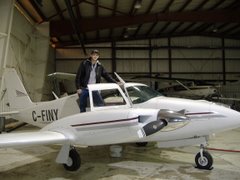I've been realizing I've been using a lot of terms in my blog that all may make sense to a pilot, but perhaps be a little obscure to any non-pilot reading. Therefore this is simply a glossary of commonly used flying terms to help make my posts a little clearer to any non-pilots reading.
Angle of Attack - The angle the wing strikes the airflow. With the exception of vertical flight, an airplane will ALWAYS fly with a positive angle of attack, usually somewhere between 5-16 degrees. The more an airplane slows down, the greater its angle of attack will become. Up until the stalling angle (usually around 16-18 degrees), the greater the angle of attack, the greater the lift a wing produces.
ATC - Air Traffic Control.
Attitude - The angle between the aircraft's longitudinal (lengthwise) axis and the horizon. As seen from the cockpit it is how high up or down the nose of the aircraft is pointing. It can also be in reference to the aircraft's roll attitude as well as pitch attitude. If the nose of the aircraft is point above the horizon, it is in a 'nose up' attitude.
Circuit - This is a box pattern that is used to organize the flow of traffic around an airport. Typically circuits are all left turns. Each side of the box is named, and is flown in reference to the direction of the runway in use. If you were to fly one complete circuit, that would include, taking off, and climbing up to a 1000 ft above airport elevation on the 'departure leg'. Then you'd turn left 90 degrees and fly the 'crosswind leg'. Your next 90 degree turn would put you on the 'downwind leg', parallel to the runway and in the opposite direction of your take-off. Left again would put you onto your 'base leg', and one final turn would once again line you up with the runway and put you on the 'final leg'. Every airplane taking off and landing has to observe certain rules involved with joing, flying, and departing the traffic circuit.
CPL - Commercial Pilot License
IFR - Instrument Flight Rules. All pilots flying according to IFR are flying by reference to their instruments. They may fly through and above clouds, and don't have to see the ground. Airlines always fly IFR.
PPL - Private Pilot License
Stall - This is when a wing has an angle of attack too great to produce lift, and the airplane's nose will pitch down into a dive. The term 'stall' has nothing to do with the engine.
Stalling Angle - The angle of attack of which the airflow over the wing becomes turbulent and stops producing lift. Every airplane has a stalling speed which corresponds to the stalling angle.
VFR - Visual Flight Rules. All pilots flying according to VFR are flying visually. They cannot fly through clouds, or above the clouds if they can't see the ground. Different to IFR (Instrument Flight Rules)
V-speeds - Airplanes all have certain airspeeds defined for certain things, and are referenced as V-speeds. For example, Vy (which should be written as an uppercase V with a subscript y) is the speed at which an aircraft will climb at its best rate. A Piper Twin Comanche's Vy is 112 mph. This means that if pitch the nose up until the airplane slows to 112 mph, we will be climbing at the fastest possible rate for that power setting. Other common examples of V-speeds include: Vr - Take-off Rotation speed, Vs - Stall speed, Vne - Never exceed speed.
Subscribe to:
Post Comments (Atom)




No comments:
Post a Comment